Photography by Mike Fizer
While the debate about how to create an unleaded avgas for general aviation continues, Cessna leapfrogged the issue with its big announcement at EAA AirVenture this summer—a diesel engine for the Cessna 182 Skylane. Although the SMA SR305-230E engine works off the principles of a diesel engine, it is optimized to only burn Jet A fuel, which is available on airports worldwide—making the new 182 JT-A model especially appealing in parts of the world where conventional avgas is rare and breathtakingly expensive or simply not available.
When it becomes available in mid-2013, the JT-A will replace the current Turbo 182T turbocharged model of the Skylane. The normally aspirated Skylane will continue in production for at least the next two years, according to Cessna officials.
Delivering the same 230 turbocharged horsepower as the Lycoming in the Turbo 182T, the SMA turbocharged diesel yields similar performance but on much less fuel. For example, in the climb, the Turbo 182T needs about 24 gallons per hour, whereas the engine electronic control unit (ECU) in the JT-A will not deliver any more than 12.5 gph to the diesel under any circumstance. The Turbo 182T reaches its best speed of 165 KTAS at about 20,000 feet, where it can still produce some 80 percent power and will be burning about 15 gph.
The SMA engine is optimized for lower altitudes, more typical of where Skylane pilots fly. The turbocharger’s critical altitude, the altitude where engine power starts to decline, is 10,000 feet with the JT-A reaching its top speed of 156 KTAS at 12,000 feet, while burning about 11.5 gph. Primary engine management will be done by percent of power; at 55 percent, the JT-A can run at 120 KTAS for some 11 hours and cover about 1,400 nm, making it quite the traveling machine if you’re not in a hurry.

Unlike the Lycoming’s turbocharger—managed by a wastegate and including a pop-off valve—the SMA engine uses a self-regulating turbocharger, which requires no wastegate or pop-off valve. The result is a lower-maintenance, simpler installation. Still, even with a three-blade composite propeller from Hartzell, the diesel engine installation is about 12 to 15 pounds heavier than the Lycoming. In addition, because Jet A is heavier than avgas, the JT-A fuel weighs 64 pounds more. However, with its significantly lower fuel burn, the JT-A can leave that weight behind in fuel and still fly farther than the avgas-powered model.
In fact, Cessna Test Pilot Charles Wilcox reports that the company launched a Turbo 182 and the JT-A together on a 1.3-hour round-robin trip. At the end of it, the JT-A top off cost $63 less than the avgas airplane as a result of the price difference in Jet A and lower fuel burn. In the United States in late August, Jet A averaged about 45 cents a gallon less than avgas—about 8 percent cheaper. In Europe and many other parts of the world, Jet A can be half the cost of avgas.
In addition, the SMA engine will likely demand less maintenance. Out of the box its TBO will be 2,400 hours, compared to 2,000 for the Lycoming engine. Wilcox believes the TBO will quickly be lifted to 3,000 hours and ultimately may be done on condition. In general, diesel engines, which must be more robust in order to handle the extreme pressures of compression ignition as opposed to spark-plug ignition, use less oil and require less maintenance than gasoline-powered engines.
Of course, buyers will expect lower operating costs to help offset the price delta between the two models. The 2013 Turbo 182 is scheduled to be priced at about $480,000 whereas the JT-A commands $515,000. Both come standard with a Garmin G1000 cockpit and a built-in oxygen system.
While simple to operate with its single-lever power control (at anything above about 50 percent power, the prop turns at 2,200 rpm continuously, so there is no prop control; the ECU handles mixture control), the JT-A demands pilot patience on start-up and practice for landing.
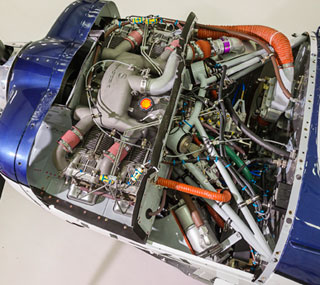
The inlet on the pilot’s side provides cooling to the large oil cooler just ahead of the firewall. A separate oil radiator provides warm air for the cabin.
The engine can’t be started at temperatures below minus 20 degrees Celsius (minus 4 degrees Fahrenheit). Below 0 degrees C, the ECU puts glow plugs in the four cylinders into an automatic sequence, requiring from six to 20 seconds to warm the air in the cylinders. At that point, a Crew Alerting System (CAS) message on the Garmin displays tells the pilot when it is safe to crank the engine.
The engine starts quickly and easily with the turn of a key—like starting a car. However, once started, the engine cannot be operated above 1,500 rpm until oil temperature reaches at least 150 degrees F. When I flew the airplane in Wichita it took several minutes for the oil to warm up. Wilcox later told me a replacement oil thermostat reduced the time to warm the oil.
Once in flight, the airplane handled just like a Skylane, with the engine responding predictably throughout a stall series. Landing at Kingman, Kansas, Wilcox advised me to slow the airplane on downwind to near the landing speed. Because a diesel engine does not like to be driven by the propeller—it wants a load on it at all times—the prop is set to go to a near zero-thrust setting at idle, which provides little drag from the prop. As a result, the airplane is hard to slow down. With fixed gear, once the flaps are deployed, the pilot is about out of drag options to further slow the airplane, except for slips. Those new to the JT-A will want to practice their speed and energy management on long runways before attempting landings at short strips. Wilcox said the company is considering the addition of speed brakes.
At 11,000 feet, we saw a true airspeed of 156 knots at 90 percent power, which is a typical cruise setting. At only 2,200 rpm, the airplane is relatively quiet in flight and those on the ground for our takeoffs and low passes reported the engine to be significantly quieter than conventional airplanes.
While the ECU manages the engine based on the pilot’s selected throttle setting, the pilot has options should the ECU fail or in the case of a complete electrical failure. Then, the pilot slides the red lever to the right of the throttle up and aft. At that point, the ECU is disconnected, restoring a mechanical connection between the throttle and the engine’s fuel rack.
Aside from these few operating differences, pilots will appreciate the versatility the Jet-A-fueled 182 brings to the market, perhaps opening the door to additional models being available to diesel and providing a path to an unleaded future.
Email [email protected]
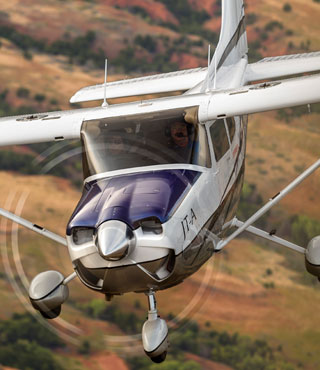
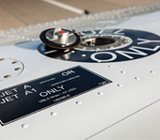
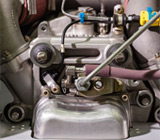
Decals and a Jet-A slotted fuel filler port is meant to keep avgas out of JT-As. The co-pilot-side inlet is for the turbocharger.
SMA SR305-230E Basics

The 230-horsepower 230E is a 305-cubic-inch horizontally opposed four-cylinder, four-stroke turbocharged air/oil-cooled compression-ignition engine designed to burn most all variants of Jet-A fuel; it is not designed to burn diesel fuel, despite the fact that it is a diesel engine. The engine drives the constant-speed prop directly; there is no gearbox, which is common on other aviation diesels. Renault racing engineers designed the engine from the ground up as an aircraft engine.
Compression-ignition engines have no ignition system or spark plugs. Instead the fuel explodes inside the cylinder because of the high compression, 15:1 in this case. By comparison, the avgas-powered Turbo Skylane’s Lycoming TIO-540-A has a compression of 7.3:1. Whereas on takeoff you might see manifold pressures of about 40 inches on a turbo avgas engine, on the SMA engine they will typically be between 84 and 94 inches—which is jaw-dropping the first time you notice it in flight!
An engine-driven fuel pump delivers fuel at 16,000 psi; about half the fuel is recirculated back to the main tanks. The warm recirculated fuel is expected to allow Cessna to certify the airplane for flight without the use of the anti-icing additive Prist. Without the warmed fuel, water molecules commonly found in Jet A could freeze at altitude, causing ice crystals to clog the fuel filter. Even with the warmed fuel, should any ice crystals form, Cessna engineers believe that the fuel filter, which is located inside the high-pressure pump, will be warm enough to melt the crystals.
An auxiliary electric fuel pump can be used to boost fuel to the high-pressure pump at altitude should vapor lock become a problem. —TBH
Long-burning desire for diesel
As with many announced aviation projects, the SMA engine has been a long time coming. I was at the Paris Air Show in 1997 when Renault, whose racing team engineers developed the engine, announced the project. The then-250-horsepower engine, which was first flown on a Socata TB20, was scheduled to be certified in mid-1998. They then planned to develop 180- and 300-horsepower variants.
The project languished through multiple corporate mergers and acquisitions. SMA, a division of the French company Safran, gained STC approval for the Cessna 182 and has had about 50 aircraft flying for several years, collecting data and continuing to refine the design; the engine is already certified in Europe and the United States. Meanwhile, SMA sold the design of that original engine to Continental Motors, which has continued its own refinement process and announced at EAA AirVenture 2012 that three variants of that engine will be brought to market over the next five years. Like Lycoming—a subsidiary of Cessna parent company Textron and the company that will provide support for the SMA engines—Continental has had numerous fits and starts with various diesel projects over the years.
The 230-horsepower SR305-230E soon to be certified on the 182 is what SMA calls the “enhanced” version of its engine, thus the “E” in the designator. According to Cessna’s Charles Wilcox, the E engine is a culmination of all the learning and improvements that SMA gained from the original engine series.
The JT-A is not Cessna’s first foray into the diesel world. In 2007 it announced plans to deliver the 172 with a 155-horsepower Thielert turbodiesel engine. However, in 2008 Thielert filed for bankruptcy and Cessna suspended the program. —TBH
Diesel Brotherhood
By Thomas A. Horn
Cessna’s 182 JT-A is set to go to market, but that airplane’s SMA SR305 turbodiesel isn’t the only game in town. Two other diesel engines of European origin have been flying for several years. First came Thielert Aircraft Engines’ TAE-125 engines, which were produced in 1.7- and 2.0-liter versions and powered Diamond Aircraft’s DA42 Twin Stars. It was an unhappy marriage. Thielert’s engines proved less than robust, couldn’t be overhauled (instead, you buy a new engine at the overhaul time of 1,200 hours), and needed their clutches overhauled and gearboxes inspected at 300-hour intervals. It got worse. In 2008, Thielert went bankrupt, and criminal charges were levied against company CEO Frank Thielert. He was accused of falsifying invoices to artificially boost his bottom line. At one point in 2008 Thielert said it would not provide warranty support.
Diamond was mightily displeased, dropped the Thielerts, and set to building its own engines. It created a subsidiary company—Austro Engines—to do this and now the 170-hp Austro Engines AE300 powers the newest Twin Stars, dubbed DA42 NGs. Like the Thielert engines, the AE300 uses a Mercedes-Benz automobile engine as its platform. Austro retains the original Mercedes pistons, camshafts, valves, crankshaft, cast-iron crankcase, and other major components. The result is an engine that’s heavier, but more durable. Thielert gave its Mercedes engines aluminum crankcases and top end components of its own design.
Today, Diamond is planning to offer the AE300s in two new Twin Stars: The 197-knot DA52-VII and the 193-knot DA42-VI. And the company has branched out to develop a new round of Austro diesels. Its 55-horsepower AE50R engine is designed for motorgliders, and its 280-horsepower AE500 is being considered for use in Diamond’s anticipated 200-knot DA50 SuperStar.
Meanwhile, the Thielert line, now reconstituted as Centurion Aircraft Engines, services existing Thielert engines and has extended their maintenance and inspection intervals. It has developed a new 155-horsepower turbodiesel, and has pursued the retrofit market with an eye to providing Thielert engines for European-based Cessna 172s and Robin DR400s.
Email [email protected].
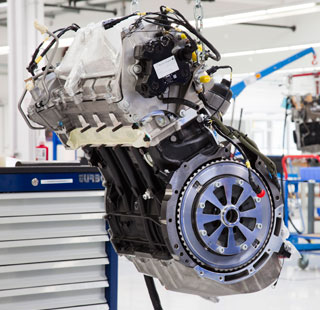
Austro AE300



